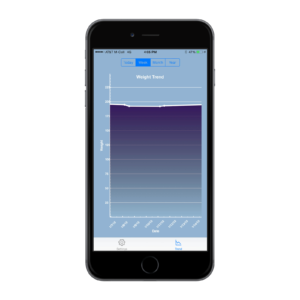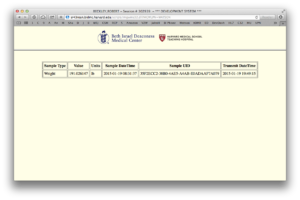By John Halamka, MD
Twitter: @jhalamka
I have long believed that social networking concepts, mobile devices, analytics, and cloud are key tactics for the success of any IT organization. We’re in an era as significant as the mainframe to PC revolution in which BYOD devices and apps are becoming the platform of choice. Given the regulatory/compliance mandates for security, the need for auditability, and the need for provenance (can we trust the data?), implementing a mobile strategy in a healthcare environment can be tricky business.
Here’s an update on two projects we’re working on now that attempt to balance functionality with security.
We’ve written an iOS app that enables patients to connect their home devices with BIDMC clinical systems using HealthKit as middleware.
Below is a screen shots of the application in use. My staff have been testing it with electronic scales that report weight to HealthKit.
 App users do a one time registration to give the BIDMC app permission to read values from Healthkit. They also login to our Personal Health Record, Patientsite, one time to enable upload. Then the App gets called by the iOS operating system whenever there is a new weight entry into Healthkit. The new weight entries (since last successful upload) are automatically uploaded and the user gets a notification of success.
App users do a one time registration to give the BIDMC app permission to read values from Healthkit. They also login to our Personal Health Record, Patientsite, one time to enable upload. Then the App gets called by the iOS operating system whenever there is a new weight entry into Healthkit. The new weight entries (since last successful upload) are automatically uploaded and the user gets a notification of success.
Here’s how the data appears in the BIDMC systems. Each transaction is logged with a universal ID, date/time and provenance ensuring data integrity and traceability of each data element. We’ll pilot the application and then enhance its usability based on lessons learned. We’ll continue our work to determine what alerts/reminders are sent to clinicians, care managers, and family members based on variation in the data provided by home devices. Weight changes can predict fluid retention leading to congestive heart failure exacerbations. Blood pressure tracking can support personalized adjustment of medications. Shared glucometer data can lead to better control of glucose over time. Very exciting possibilities.
We’ll pilot the application and then enhance its usability based on lessons learned. We’ll continue our work to determine what alerts/reminders are sent to clinicians, care managers, and family members based on variation in the data provided by home devices. Weight changes can predict fluid retention leading to congestive heart failure exacerbations. Blood pressure tracking can support personalized adjustment of medications. Shared glucometer data can lead to better control of glucose over time. Very exciting possibilities.
One of the downsides of BYOD is that smartphone photography can lead to privacy issues such as revealing clinical information inappropriately, should the photograph become available on a social network or publicly available website. BIDMC is piloting a new camera created by Ricoh that uploads photos to the electronic health record and deletes them from the camera immediately, enabling photographs to be curated via the all the usual policy and technology controls surrounding the electronic health record.
If the pilot is successful, we can then change policy at BIDMC, requiring that purpose built, EHR connected, secure cameras be used for all clinical photography. The combination of technology and policy should reduce risk.
We continue to explore options to make our workforce more mobile, procuring services that enhance productivity and usability while protecting security and safety. More to come!
John D. Halamka, MD, MS, is Chief Information Officer of Beth Israel Deaconess Medical Center, Chairman of the New England Healthcare Exchange Network (NEHEN), Co-Chair of the HIT Standards Committee, a full Professor at Harvard Medical School, and a practicing Emergency Physician. This article was originally published in his blog Life as a Healthcare CIO and is reprinted here with permission.

